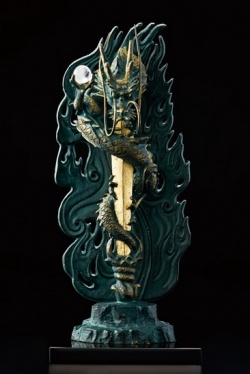The Wisdom King Fudoo Myoo-oo and the Sword Kurikara
The unmovable Fudoo (Acala Vidyaaraaja) is one of the Wisdom Kings (Myoo-oo). He is usually depicted in a very wrathful way. He is a typical Japanese deity, introduced by Kooboo Daishi about 806 and soon became a special protector of the Mountain Ascetics (yamabushi). An impressive waterfall is considered the personification of Fudoo, for example the Great Waterfall at Nachi, which we met in the story about Kumano.
Fudoo is portrayed holding a two-edged sword with a three-pronged hilt in his right hand and a coiled rope in his left hand. With this sword of wisdom, Fudoo cuts through deluded and ignorant minds and with the rope he binds those who are ruled by their violent passions and emotions.
Kurikara Fudo is another personification of this deity, this time in the form of a Dragon-Sword. The Dargon King Kurikara (Sanskrit: Kulikaa Nagaraajaa) is said to have a golden body color and is sometimes depicted with one or two horns on his head.
Legend has it that Fudoo had to fight the representative of a different religion. He changed himself into a flaming sword but the opponent did the same and the fighting went on without a winner. Now Fudoo changed himself into the Dragon Kurikara, wound himself around the opposing sword and started eating it from the top. This episode gave rise to the iconographic rendering as we know it now.
The dragon used to be a vasall or symbol of the deity, but in this unique case the symbol and the deity came to be honored as the same thing. Especially during the Edo period where the sword was a symbol of the vasall's loyalty to his lord, the statues and steles of Kurikara Fudoo were produced in greater numbers.
This Kurikara Fudoo is the protective deity of a waterfall of Terazawa.
The unmovable Fudoo (Acala Vidyaaraaja) is one of the Wisdom Kings (Myoo-oo). He is usually depicted in a very wrathful way. He is a typical Japanese deity, introduced by Kooboo Daishi about 806 and soon became a special protector of the Mountain Ascetics (yamabushi). An impressive waterfall is considered the personification of Fudoo, for example the Great Waterfall at Nachi, which we met in the story about
Fudoo is portrayed holding a two-edged sword with a three-pronged hilt in his right hand and a coiled rope in his left hand. With this sword of wisdom, Fudoo cuts through deluded and ignorant minds and with the rope he binds those who are ruled by their violent passions and emotions. Kurikara Fudo is another personification of this deity, this time in the form of a Dragon-Sword. The Dargon King Kurikara (Sanskrit: Kulikaa Nagaraajaa) is said to have a golden body color and is sometimes depicted with one or two horns on his head. Legend has it that Fudoo had to fight the representative of a different religion. He changed himself into a flaming sword but the opponent did the same and the fighting went on without a winner. Now Fudoo changed himself into the Dragon Kurikara, wound himself around the opposing sword and started eating it from the top. This episode gave rise to the iconographic rendering as we know it now.
The dragon used to be a vasall or symbol of the deity, but in this unique case the symbol and the deity came to be honored as the same thing. Especially during the Edo period where the sword was a symbol of the vasall's loyalty to his lord, the statues and steles of Kurikara Fudoo were produced in greater numbers. This Sword Fudo watches over a watering place in a gourge of a mountain pass near Hachioji, Tokyo. There are many poisonous snakes in this area and many people died of their bites. Since the statue was erected in around 1770, Fudo protects the humans. The present statue dates from the Meiji period.
The area is also called Fudo Valley, Fudo Yatsu 不動谷津.
There is also an old mountain cherry tree close by, said to be more than a few hundred years old, with a diameter of about three meters. Kobo Daishi came to this region in the footsteps of En no Gyoja, carved a statue of the Great Fudo and performed sacred rites to honor this statue.
The deity would ward off evil influence and protect the pilgrim from dangers
